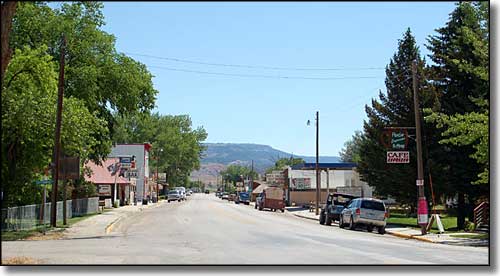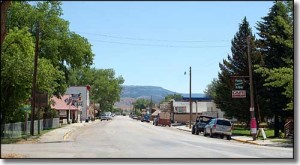The President hopes an increase in Internet access will result in more economic development. Fiber networks would do that better than mobile broadband
The residents of Ten Sleep, Wyo., know the meaning of rural. They didn’t have phone service until the 1950s, when Tri-County Telephone Assn., a municipal cooperative, used federal subsidies to string copper wire to every home. In 2005 the co-op upgraded to fiber-optic cable, giving the town’s 300 residents Internet access at 20 megabits per second. For the technically unfamiliar, Chris Davidson, Tri-County Telephone’s general manager, describes this as “smoking fast.”
Even President Barack Obama is impressed. On Feb. 10 he rolled out a national wireless plan, pointing to Ten Sleep as an example of what he wants to replicate nationally: Because of the town’s high-speed fiber network, one company has been able to hire locals to teach English to Asians by video chat over the network. Obama hopes his plan will result in more such economic development by providing 98 percent of Americans with access to high-speed wireless Internet. “Ten Sleep,” Obama mused. “I love the name of that town.”
His plan, however, isn’t likely to create more Ten Sleep success stories. It will direct $5 billion to the Federal Communications Commission‘s Universal Service Fund, the source of subsidies that Ten Sleep and other places tapped to build plain old telephone service. The money will help the FCC shift the fund’s focus toward Internet access. The commission has released drafts for public comment that suggest the service will provide a minimum speed of 4 Mbps in hard-to-reach areas, most likely over a wireless connection. Using Davidson’s measure, this is one-fifth of “smoking fast” and an even smaller fraction of fiber’s potential. “Wireless wouldn’t have helped us,” says Rachel Casteel, a spokeswoman for Eleutian, the Ten Sleep company Obama cited.
The call centers and data-storage facilities that companies have placed in other small towns like Lebanon, Va., and The Dalles, Ore., demand the speed and capacity that only a fiber-optic backbone can provide. Davidson says he is encouraged by the fund’s shift to Internet access but is unimpressed by the slower speeds. “People in rural America,” he says, “need just as much speed as someone who’s in town.”
Article Continued on Bloomberg BusinessWeek…
Make sure you read the rest of this article because illuminates the gap between what the administration and FCC are saying versus doing. The Administration, Congress, or the FCC are not doing anything to remove the restrictions on municipalities to set their broadband future. President’s use of Ten Sleep as an example of what he wants to do is not an appropriate example because this community took responsibility for building a network that met their needs instead of a network dictated by the Central Committee. Bureaucrats and politicians in D.C. do not understand the needs of people in Ten Sleep or any other community. Our country was based on a republic to enable localities to make decisions that meet their specific needs. The federal government was designed to provide some basic national needs and help facilitate members of the republic to enact commerce.
The “National Broadband Plan,” although a good read, should not be construed as a true plan. There is no one technology, standard, or product that will meet the needs of every community, and it is not the responsibility of the FCC or any other governmental organization to determine. If a community concludes that the incumbent carriers are not meeting their broadband needs, then they should have the option of devising their own plan that will meet their needs. They should even have the option of spending or backing the project through their taxes. Large carriers have always had a strong presence at the state level that enables them to protect their business models. The federal government should ensure that there are no legal or regulatory barriers that prevent these citizens from doing what they want; thus, ensuring that the citizens can build their desired network.
“Feeds and speeds” should also be left up to the locality to decide. Although 1 Gbit/s is right for Chattanooga, Ten Sleep found 20 Mbit/s over fiber to be sufficient. They were able to build these networks without time-consuming and costly expenditures on purchasing licenses for spectrum. Mountainous or sparsely populated communities may find that wireless suits their needs like some of the WISP in Wyoming. Again the decision on a specific technology was made based on the needs of the locality building the network and not in D.C. It is not the Administration’s role to support one industry over another another.
The President and FCC should follow the examples of towns like Ten Sleep, Chattanooga, and other successful municipal broadband network communities. They should let each town determine what to build based on community needs, and they should facilitate the building of those networks. I personally do not believe that local governments should be in the telecommunications services business, but I do believe that they can forge a public/private partnership to build an open-access network for service providers to sell their services. That way service providers like CenturyLink, Frontier, Verizon, Comcast, and others can sell their services in those communities. The USF and Connect America Funds should include municipalities in the disbursement of those monies. Just following through on those simple two items will do more to close the broadband gap than any grand plan from Washington.
Related articles
- Broadband map shows up to 10% in U.S. lack good Internet (usatoday.com)
- High-speed wireless access for entire US will spark innovation, Obama says – Christian Science Monitor (news.google.com)
- Slow Broadband Speed Still a Problem for U.S. (cbsnews.com)
- Obama’s Call for Wireless (technologyreview.com)


